How it used to be pre-0.8.0
In brief, planes got shot down with a certain probability (dependent on AA potential), and the planes, in fact, did not have effective individual hit points. At the same time, AA mounts did not have minimal range, so AA generally grew a lot stronger closer to the ship. It caused two issues:
- Probability-based and erratic plane destruction used to create too much RNG — sometimes squadrons got wiped out in a moment, sometimes AA seemed to have zero effect;
- Lack of minimal firing range interrupted with creating proper AA support specs, so that the ships could cover their allies properly, but would not be invulnerable at closer range;
How it works now
- Each plane has individual hit points. If a planes ‘dips’ into AA range, it will be damaged according to the respective AA strength, and the damage will be recorded (so it will be easier to shoot down later) indicated by the green/yellow/red HP bars.
- Each AA group has a minimum range now, so short, medium and long range AA on one ship do not overlap, which gives much more options for balancing the AA in general and gives a lot of potential for AA variety.
For example, let’s look at Baltimore AA. Close range is 0,1–1,5 km, medium is 1,5–3,5, long range covers 3,5–5,8 km.
Come funzionava l’AA prima della 0.8
In breve, gli aerei sono stati abbattuti con una certa probabilità (dipendente dal potenziale di AA), e gli aerei, in effetti, non avevano punti ferita individuali efficaci. Allo stesso tempo, le montature AA non avevano una portata minima, quindi AA generalmente cresceva molto più vicino alla nave. Ciò Ha causato due problemi:
- Distruzione dell’aereo si basava sulla probabilità ed era irregolare,utilizzava troppo RNG – a volte gli squadroni sono stati spazzati via in un attimo, a volte AA sembrava avere un effetto zero;
- Mancanza di raggio di tiro minimo interrotto con la creazione di specifiche di supporto AA appropriate, in modo che le navi potessero coprire correttamente i loro alleati, ma non sarebbero invulnerabili a distanze più ravvicinate;
Come funziona ora
- Ogni aereo ha singoli punti ferita. Se gli aerei si immergono nel raggio AA, saranno danneggiati in base alla rispettiva forza AA, e il danno verrà registrato (quindi sarà più facile sparare più tardi) indicato dalle barre HP verde / giallo / rosso.
- Ogni gruppo AA ha un range minimo ora, quindi AA corto, medio e lungo raggio su una nave non si sovrappongono, il che offre molte più opzioni per bilanciare l’AA in generale e offre molte potenzialità per la varietà AA.
Ad esempio, diamo un’occhiata alla AA della Baltimore . La distanza ravvicinata è di 0,1-1,5 km, quella media è di 1,5-3,5, quella lunga copre 3,5-5,8 km.
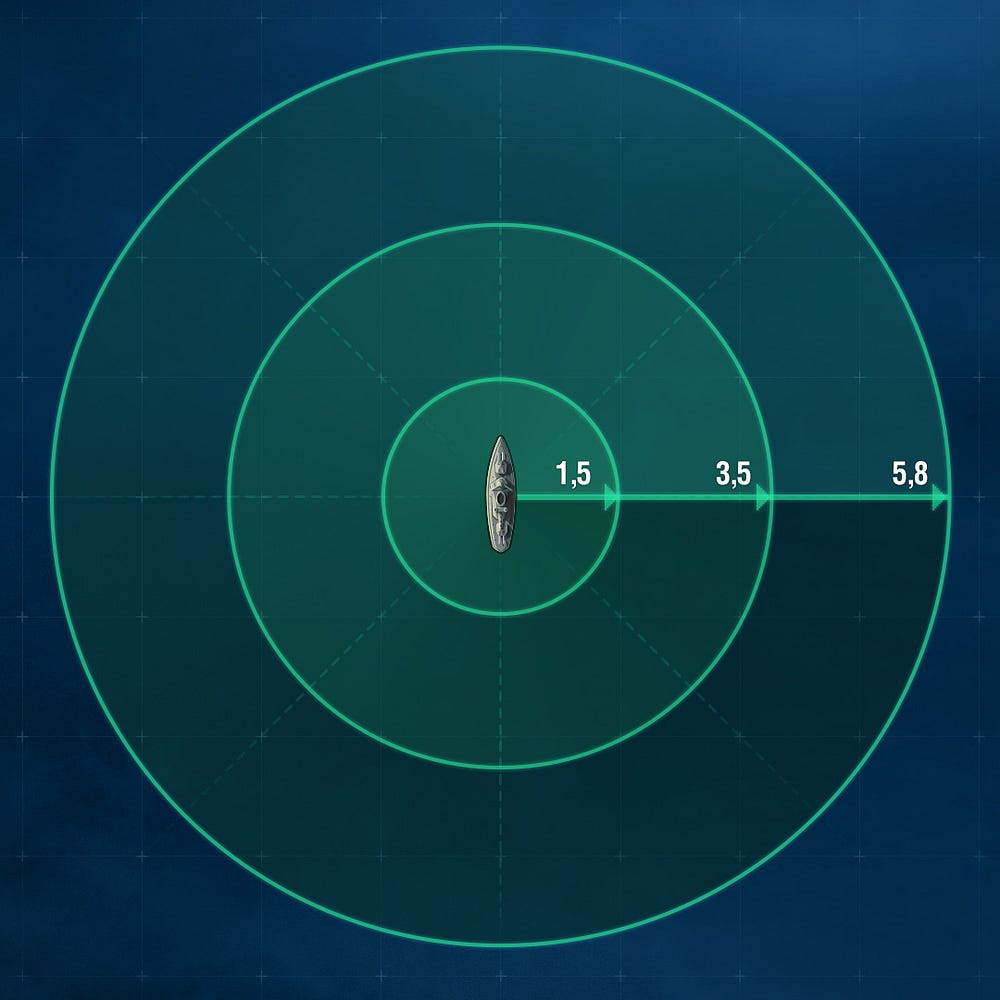
3. Now there is “hit chance” parameter for AA. It allows for a better fine tuning of AA mounts per class and tier — usually it is higher for more modern ships, which represents more modern AA fire control systems. Hit chance affects flak bursts and constant DPS.
4. AA damage is dealt in two ways now:
- Constant DPS in the respective AA range. The damage dealt is DPS multiplied with Hit chance, so, if you have 100 DPS and 70% hit chance, you will deal 70 damage per second. This damage is being dealt to each squadron in the AA range (and it’s not being spread — each squadron receives full DPS). It also worth noting that within the squadron it is being dealt to a randomly chosen plane, one at a time (basically AA quickly shoots at all planes in a squadron, plane by plane). This is why some of your planes are getting damaged a bit earlier, and some — a bit later in constant DPS area.
- Flak bursts (for medium and long range AA only). A flak burst is a specific volume in a three dimensional space, and if a plane physically gets inside it, the damage (usually very large) is applied to it (that exact plane). Actual average number of flak bursts is: base flak bursts parameter, multiplied by Hit chance.
3. Ora c’è il parametro “hit chance” per AA. Consente una migliore messa a punto di montature AA per classe e livello – di solito è più alto per le navi più moderne, che rappresentano più moderni sistemi di controllo AA. La probabilità di colpo influisce sulle raffiche di flak e sui DPS costanti.
4. Il danno AA viene distribuito in due modi:
- DPS costante nel rispettivo raggio AA. Il danno inflitto è DPS moltiplicato con probabilità di colpo, quindi, se hai 100 DPS e 70% di probabilità di successo, infliggi 70 danni al secondo. Questo danno viene distribuito a ogni squadrone nel raggio AA (e non viene distribuito – ogni squadrone riceve DPS completi). Vale anche la pena notare che all’interno dello squadrone viene assegnato a un aereo scelto a caso, uno alla volta (sostanzialmente AA spara rapidamente su tutti gli aerei di uno squadrone, aereo per aereo). Questo è il motivo per cui alcuni dei tuoi aerei sono stati danneggiati un po ‘prima, e alcuni – un po’ più tardi in un’area DPS costante.
- Scoppio di flak (solo per AA medio e lungo raggio). Un burst di flak è un volume specifico in uno spazio tridimensionale, e se un aereo fisicamente viene dentro, il danno (di solito molto grande) viene applicato su di esso (quell’esatto aereo). Il numero medio effettivo di esplosioni di flak è: parametro di burst flak di base, moltiplicato per Hit chance.
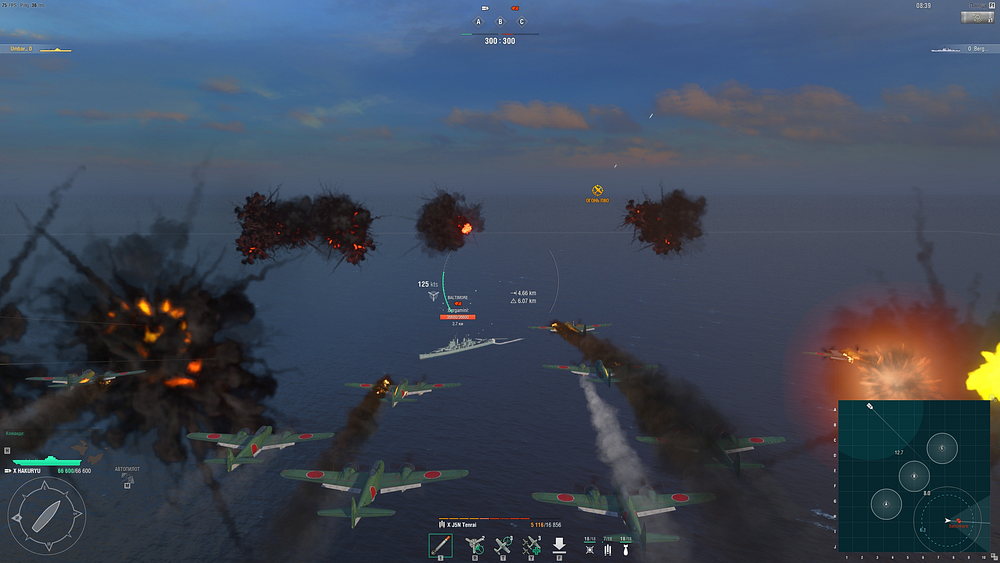
Flak bursts appear on the calculated squadron path, within the specified zones (see the picture). Mostly the bursts will be concentrated in narrow A zone directly on squadron path, and if it’s full of bursts already, the rest will go to the side B zones (which makes maneuvering more challenging).
Le raffiche di flak compaiono sul percorso dello squadrone calcolato, all’interno delle zone specificate (vedi l’immagine). Per lo più le raffiche saranno concentrate nella stretta zona A direttamente sul percorso dello squadrone, e se è già pieno di raffiche, il resto andrà alle zone laterali B (il che rende le manovre più impegnative).
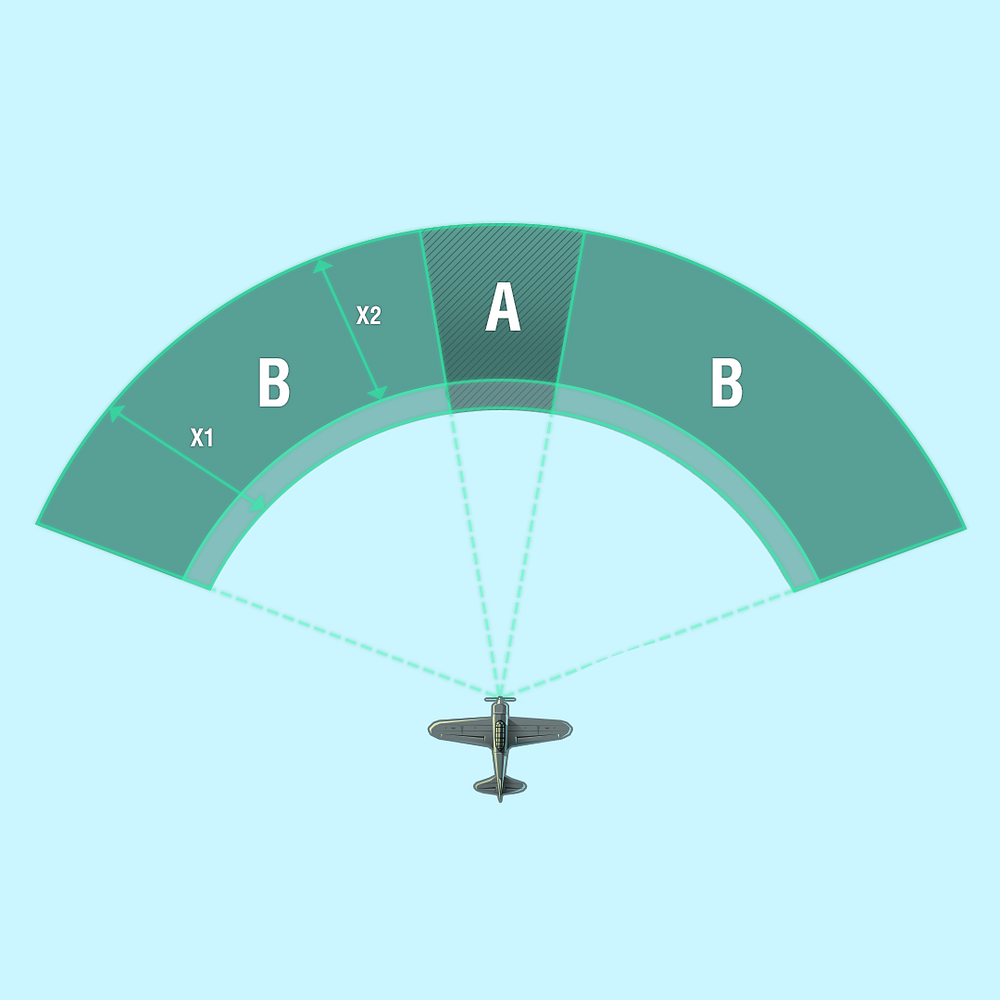
More about these flak bursts
Please note once again that the info here, especially balance values, is subject to change.
Flak bursts appear each 2 seconds. The burst “physical” size depends on AA mount caliber — larger calibre guns give bigger bursts.
Zone width (X) depends on squadron speed. It will be quite wide (X1) if current squadron speed is high, and it will be narrow (X2) if the planes are going at minimal speed. That means that using throttle is very important for dodging flak bursts.
Effective flak burst amount, as mentioned before is base flak burst parameter multiplied with Hit chance. Normal (Gauss) distribution is applied, and the minimal burst size is symmetrical to the maximum. That means that with 10 base burst size and 70% hit chance, it will mostly be 7 bursts, 10 is maximum number and 4 is minimum.
With a single ship AA, 80% of flak bursts (but not more than 6) is being placed in zone A. The rest goes to side B zones. Flak bursts do not overlap each other.
Let’s check Baltimore once again (the scaling on these pictures is simplified).
Long range AA has spawned 5 bursts, so 5 go to A zone and 1 goes to B zone.
Si prega di notare ancora una volta che le informazioni qui, in particolare i valori di bilanciamento, sono soggette a modifiche.
Le raffiche di flak appaiono ogni 2 secondi. Le dimensioni “fisiche” del burst dipendono dal calibro di AA – cannoni di calibro più grande danno esplosioni più grandi.
La larghezza della zona (X) dipende dalla velocità dello squadrone. Sarà abbastanza largo (X1) se la velocità attuale dello squadrone è alta, e sarà stretta (X2) se gli aerei stanno andando a velocità minima. Ciò significa che usare la manopola del gas è molto importante per schivare raffiche di flak.
Efficace quantità di burst di flak, come accennato prima è moltiplicato il parametro burst flak di base con Hit chance. Viene applicata la distribuzione normale (Gauss) e la dimensione minima di burst è simmetrica al massimo. Ciò significa che con 10 dimensioni di burst base e 70% di probabilità di successo, sarà per lo più 7 raffiche, 10 è il numero massimo e 4 è minimo.
Con una singola nave AA, l’80% delle esplosioni di flak (ma non più di 6) viene piazzato nella zona A. Il resto va alle zone laterali B. Le raffiche di flak non si sovrappongono l’una all’altra.
Controlliamo ancora una volta Baltimora (il ridimensionamento di queste immagini è semplificato).
L’intervallo lungo AA ha generato 5 raffiche, quindi 5 vanno in una zona e 1 nella zona B.
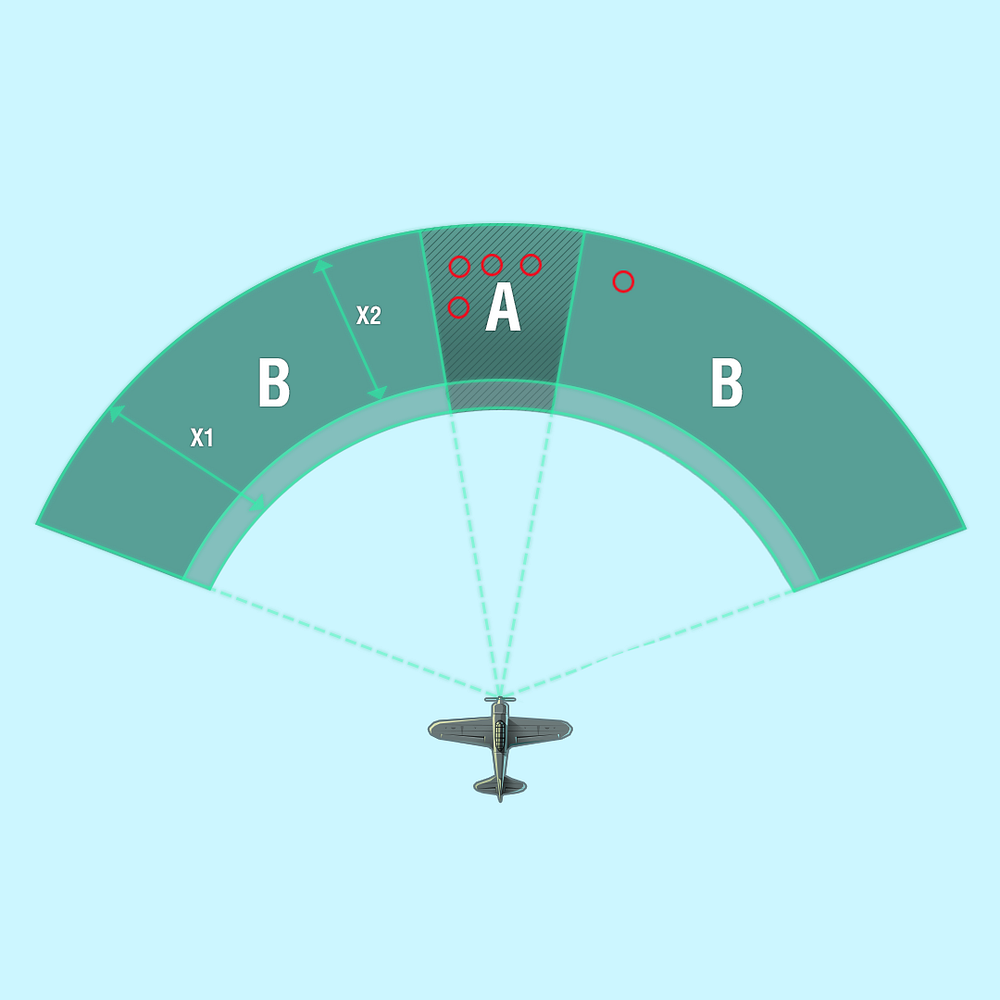
Medium range AA has spawned 11 bursts, so A zone gets 6 bursts (of lesser size) and 5 bursts go to B.
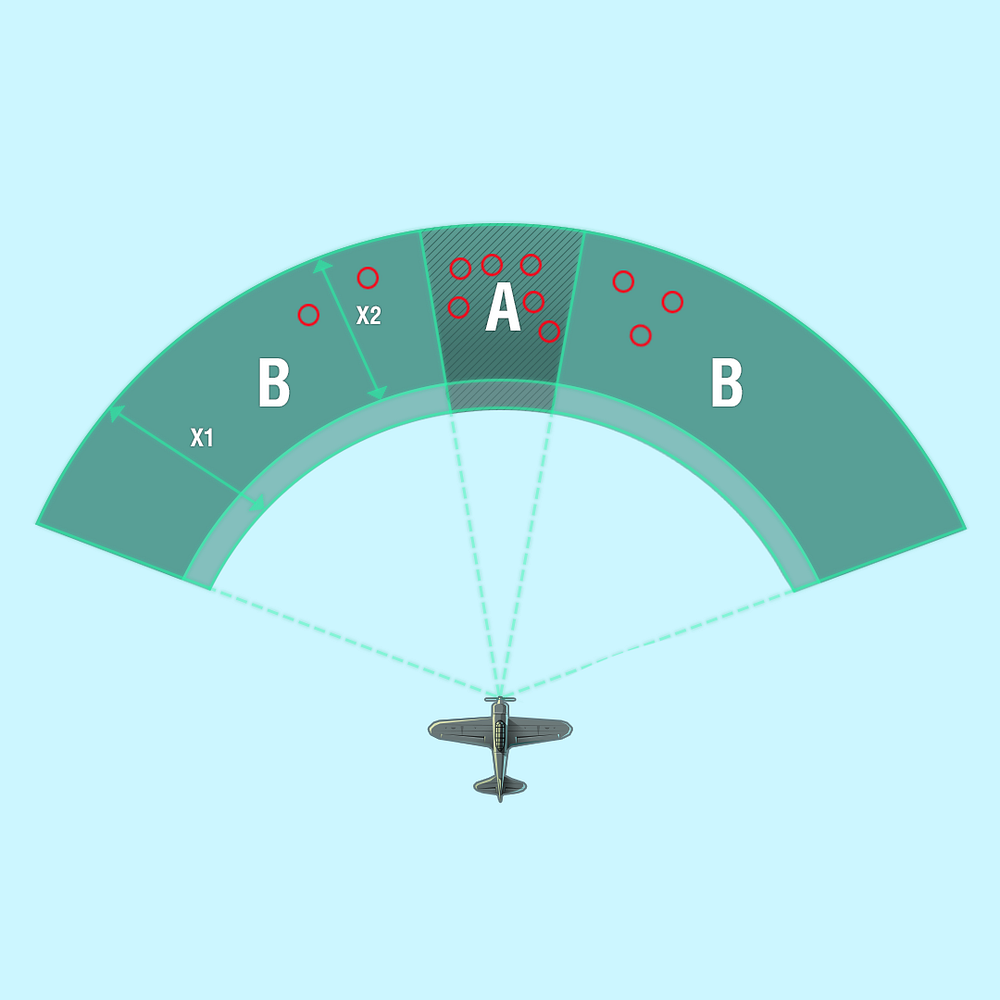
If there are several ships firing, the rules are slightly different: up to 8 bursts can be placed in A zone combined and up to 10 bursts — in A zones. The most powerful burst are being chosen in this case.
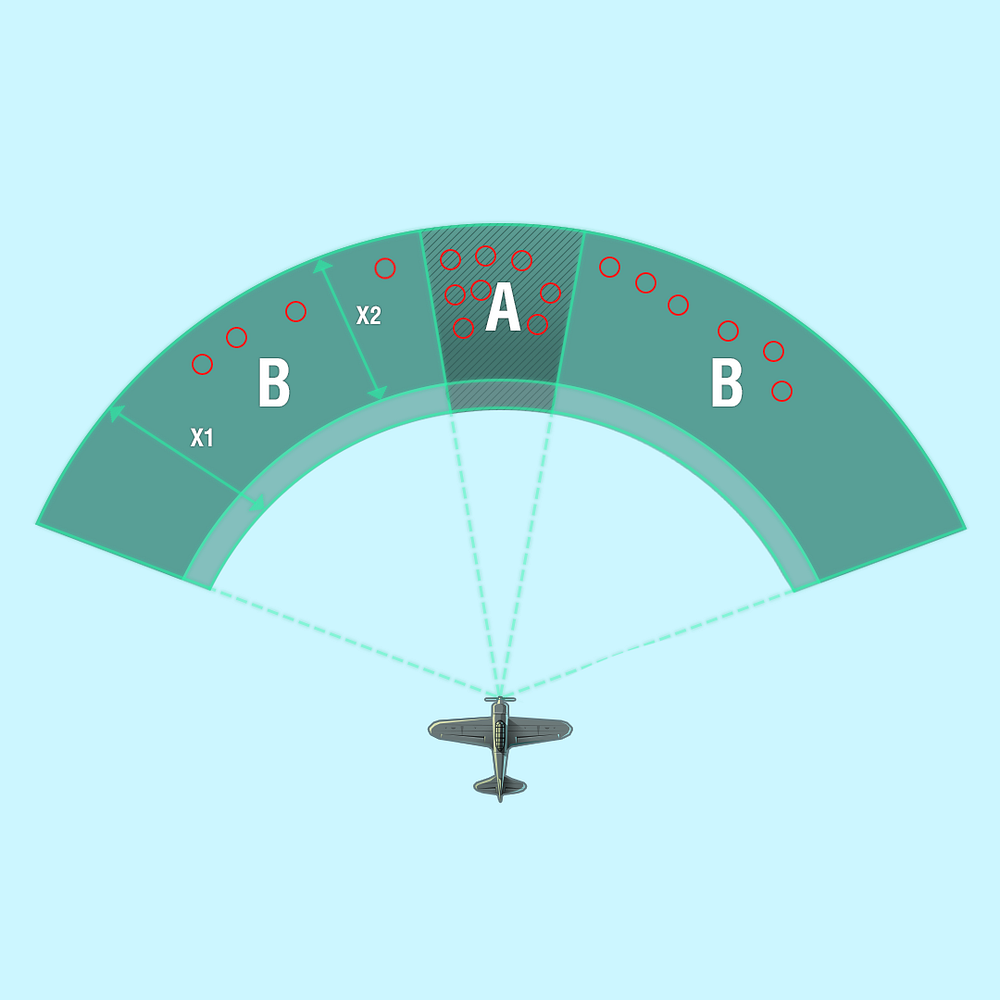
This limit gives at least slight chance for attack even against a strong AA group.
If a single AA group has multiple squadrons in range, flak bursts that would have been in B zone otherwise, are distributed into A zones so that AA covers all squadrons. That said, long and medium range AA still do not overlap, so if one enemy squadron is at medium range, and the other is at long range, that means each of them will interact with its respective AA group without any mixing and overlapping.
Questo limite dà almeno una leggera possibilità di attacco anche contro un forte gruppo AA.
Se un singolo gruppo AA ha più squadroni nel raggio d’azione, le esplosioni di flak che sarebbero state nella zona B altrimenti sono distribuite in zone A in modo che AA copra tutti gli squadroni. Detto questo, gli AA a lungo e medio raggio non si sovrappongono, quindi se uno squadrone nemico è a medio raggio e l’altro a lungo raggio, significa che ognuno di loro interagirà con il rispettivo gruppo AA senza alcuna mescolanza e sovrapposizione.
AA reinforcement and visual hints
AA can be reinforced two ways in battle.
- Defensive AA consumable: constant DPS and flak bursts damage increases, and the bursts turn red.
AA può essere rinforzato in due modi in battaglia.
- Materiale di consumo AA difensivo: il DPS costante e l’esplosione del danno da flak aumentano e le raffiche diventano rosse.
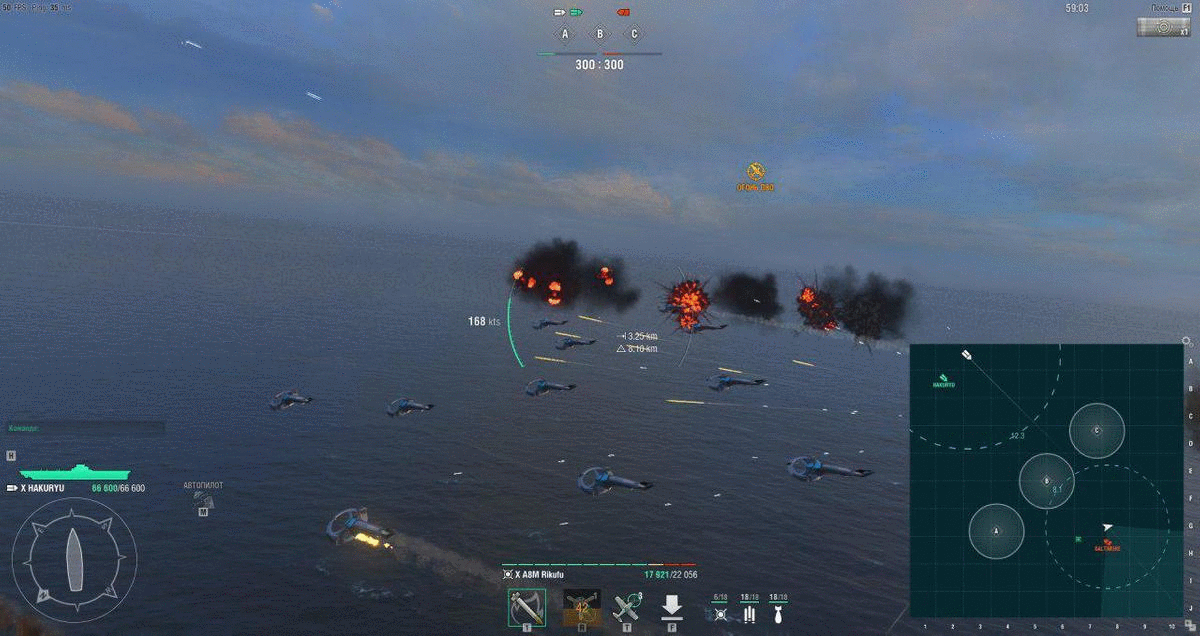
Regular bursts are orange, and defensive AA bursts are red.
Usually the increase is x2 for cruisers and x3 for destroyers.
2. AA sector reinforcement (via special menu bound to “~” and “O” keys). Constant DPS in the chosen sector is increased by 25–60% (depends on class and shown in the Port) at the expense of the other sector. AA tracers in the prioritized sector turn red.
AA sectors don’t have any transition states, they are either reinforced, normal or weakened. Changing the state takes time, so you should do it in advance. If a squadron is at the border between two sectors, the sector it is in is determined by the amount of planes; if 7 planes are in the right sector, and 2 are in the left, the squadron is considered to be in the right.
Le raffiche regolari sono di colore arancione e le raffiche AA difensive sono rosse.
Di solito l’aumento è x2 per gli incrociatori e x3 per i cacciatorpediniere.
2. Rinforzo settore AA (tramite menu speciale associato ai tasti “~” e “O”). Il DPS costante nel settore prescelto è aumentato del 25-60% (dipende dalla classe e mostrato nel Porto) a spese dell’altro settore. I traccianti AA nel settore prioritario diventano rossi.
I settori AA non hanno stati di transizione, sono rinforzati, normali o indeboliti. Cambiare lo stato richiede tempo, quindi dovresti farlo in anticipo. Se uno squadrone si trova al confine tra due settori, il settore in cui si trova è determinato dalla quantità di aerei; se 7 aerei sono nel settore giusto e 2 sono nella sinistra, lo squadrone è considerato nella destra.
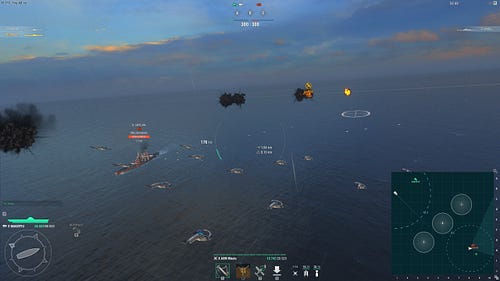
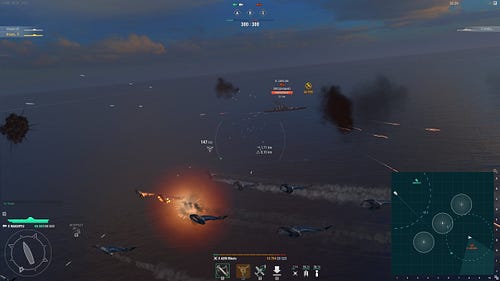
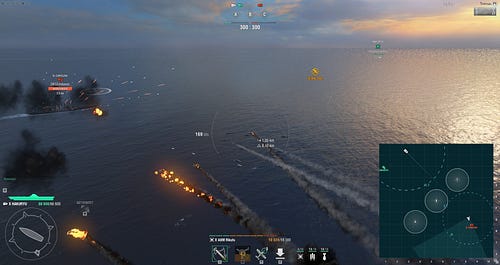
Skills and upgrades
Upgrades
AA mod.1 — slot 3 (available from tier 5)
Gives +2 to flak burst base value for long and medium range AA. Especially useful for the ships with low amount of bursts.
AA mod.2 — slot 6 (available from tier 9)
Increases both constant DPS at all ranges and flak bursts damage by 15%. A very powerful AA buff, but at the cost of other efficient upgrades in the slot.
AA mod.1 – slot 3 (disponibile dal livello 5)
Fornisce +2 al valore base burst di flak per AA lungo e medio raggio. Particolarmente utile per le navi con scarse quantità di raffiche.
AA mod.2 – slot 6 (disponibile dal livello 9)
Aumenta sia il DPS costante a tutti i raggi di azione che il danno da raffiche di flak del 15%. Un buff AA molto potente, ma a costo di altri aggiornamenti efficienti nello slot.
Skills
- (I) Direction center for fighters — +1 Fighter when you use the respective consumable;
- (III) Basic firing training — Increases constant DPS at all ranges by 10% (and increases rate of fire of all secondaries and main guns of caliber up to and including 139mm by 10%);
- (IV) Advanced firing training — Increases flak burst damage by 15% (and increases range of fire of all secondaries and main guns of caliber up to and including 139mm by 20%);
- (IV) Manual Fire Control for AA Armament — increases the efficiency of sector reinforcing by 20% (which means 150% from 125%, for example) and reduces the time for switching by 20%.
- (I) Centro di direzione per i Caccia, +1 Combattente quando si utilizza il rispettivo materiale di consumo;
- (III) Addestramento di tiro di base – Aumenta il DPS costante a tutti i range del 10% (e aumenta la velocità di fuoco di tutti i secondari e le principali armi di calibro fino a 139 mm compresi del 10%);
- (IV) Addestramento di fuoco avanzato – Aumenta il danno da deflagrazione del flak del 15% (e aumenta il raggio di fuoco di tutti i secondari e le principali armi di calibro fino a 139 mm compresi del 20%);
- (IV) Controllo manuale del fuoco per AA Armament – aumenta l’efficienza del rinforzo del settore del 20% (che significa ad esempio 150% dal 125%) e riduce il tempo di passaggio del 20%.
So how do I maximize my AA defense?
First of all, AA reinforcement influences only constant DPS, so if you want to play around it, you better pick a ship with a lot of constant DPS. Additionally keep in mind that the switching time is different per class — 5 seconds for destroyers, 10 seconds for cruisers, 12 seconds for battleships and 15 seconds for carriers.
Using this mechanic will require extra attention from you, but in return you will increase the type of damage that is constant and impossible to dodge. With Manual Fire Control your damage multiplier gets even more serious — x1,5 for cruisers and battleships, x1,8 for destroyers and x1,92 for carriers.
What’s even better, you can maximize this DPS with Basic Firing Trainng — and that skill is useful for most destroyers and secondary-specced battleships.
Advanced firing training is especially useful for the ships with low constant DPS and high amount of flak bursts, and it combines well with AA mod.1. As with Basic Firing Training, this skill is beneficial for secondaries and small caliber main guns.
Direction center for fighters can be very influential on low level, where the fighter squadron is small. Overall, we would recommend it only as the last priority, or when you have 1 extra point to spend.
Prima di tutto, il rinforzo AA influenza solo i DPS costanti, quindi se vuoi giocare intorno a te, scegli una nave con un DPS costante. Inoltre, tieni presente che il tempo di commutazione è diverso per classe: 5 secondi per i cacciatorpediniere, 10 secondi per gli incrociatori, 12 secondi per le navi da guerra e 15 secondi per i corrieri.
L’utilizzo di questa meccanica richiederà un’attenzione particolare da parte tua, ma in cambio aumenterai il tipo di danno che è costante e impossibile da schivare. Con Manual Fire Control il tuo moltiplicatore di danno diventa ancora più serio: x1,5 per incrociatori e navi da guerra, x1,8 per cacciatorpediniere e x1,92 per corrieri.
Cosa c’è di meglio, puoi massimizzare questo DPS con Base Firing Trainng – e quell’abilità è utile per la maggior parte dei cacciatorpediniere e delle navi da battaglia secondarie.
L’addestramento avanzato al tiro è particolarmente utile per le navi con DPS a bassa costanza ed elevata quantità di raffiche di flak, e si combina bene con AA mod.1. Come per l’addestramento al tiro di base, questa abilità è utile per le secondarie e i cannoni principali di piccolo calibro.
Il centro di direzione per i combattenti può essere molto influente a livello basso, dove lo squadrone da combattimento è piccolo. In generale, lo consigliamo solo come ultima priorità o quando hai 1 punto in più da spendere.
What are the best maneuvers when being attacked by different squadrons?
- Attack planes deal the least amount of damage, but they are very fast, agile and relatively easy to aim. Their rocket dispersion is different per game nation, so you should typically not expose broadside to the USN attack planes, and try to avoid going bow or aft against IJN and RN planes.
- Dive bombers are usuall slower and it’s hard for them to adjust their aim while in the attack run. That means quick maneuvering is the key, and, as their dispersion pattern is usually long, they deal the most damage with bow or aft attack runs.
- Torpedo bombers have different attack run patterns per nation, but they have one common thing — they always try to catch you broadside to maximize the number of hits. USN torpedo bombers usually carry more torpedoes per attack, but they have more challenging aiming, so evasive maneuvers in advance will make their life much more difficult. IJN torpedo bombers usually carry torpedoes with relatively long range, so beware of long drops and pay attention even if they do something on the edge of your visibility.
Remember about other enemies while dodging CV attacks. Sometimes it’s better to take some damage from a CV instead of exposing your broadside to its BB allies.
And as a destroyer, don’t forget about “P” button which turns AA off. You typically have great concealment, and being spotted late can be more advantageous than firing your AA immediately. If you appear close enough, the enemy squadron can easily fly overhead and miss the first attack run.
We hope this article was useful and you now have a better and clearer understanding of AA mechanics now.
Thank you!
source – medium wows devs blog
- Gli aerei di attacco infliggono il minor numero di danni, ma sono molto veloci, agili e relativamente facili da mirare. La loro dispersione di razzi è diversa per nazione di gioco, quindi in genere non dovresti esporre a bordo degli aerei di attacco USN, e cercare di evitare di andare a prua o di poppa contro gli aerei IJN e RN.
- I bombardieri di picchiata sono di solito più lenti ed è difficile per loro regolare la mira mentre sono in attacco. Ciò significa che una rapida manovra è la chiave e, dato che il loro schema di dispersione è solitamente lungo, infliggono il maggior numero di danni con tiri di prua o di poppa.
- Gli aerosiluranti hanno schemi di attacco diversi per nazione, ma hanno una cosa in comune: cercano sempre di afferrarti a lato per massimizzare il numero di colpi. Gli aerosiluranti USN di solito trasportano più siluri per attacco, ma hanno una mira più impegnativa, quindi le manovre evasive in anticipo renderanno la loro vita molto più difficile. Gli aerosiluranti IJN di solito trasportano siluri con un raggio relativamente lungo, quindi fai attenzione alle lunghe cadute e fai attenzione anche se fanno qualcosa sul bordo della tua visibilità.
Ricorda altri nemici mentre schivi gli attacchi CV. A volte è meglio prendere qualche danno da un CV invece di esporre la tua Broadside ai suoi alleati BB.
E come cacciatorpediniere, non dimenticare il pulsante “P” che spegne AA. Di solito hai un buon nascondiglio e essere individuato in ritardo può essere più vantaggioso che usare immediatamente il tuo AA. Se ti sembra abbastanza vicino, lo squadrone nemico può volare facilmente sopra la testa e saltare la prima corsa di attacco.
Speriamo che questo articolo sia stato utile e ora hai una comprensione migliore e più chiara dei meccanismi AA.
Grazie!


Hi, I thought the new changes would be great i like playing as well as carriers, after this you have pretty much made this game so one sided and bad against carrier players. im lucky if i get any where near ships and when i do i get cut to pieces you really have cocked this game up in a very big way! i refuse now to waste my time and effect and planes on attacks on ships as its pointless so now i have found a new way of enjoying the game i bomb the towns and houses on the island yes it pisses my team mates off but i simple refuse to get pissed off anymore seeing all my aircraft wiped out as playing a carrier has become a joke now! please put more houses on the islands and air fields and explosions and fires after i bomb them please. me and this other carrier enjoyed bombing the houses together yes we had team mates angry as we were not helping them against reds lol but who cares it seems World of Warshits dont care so neither do we lol you want me and other carriers to change are game play then make it fair for us too or we will simple carry on bombing houses on the islands!